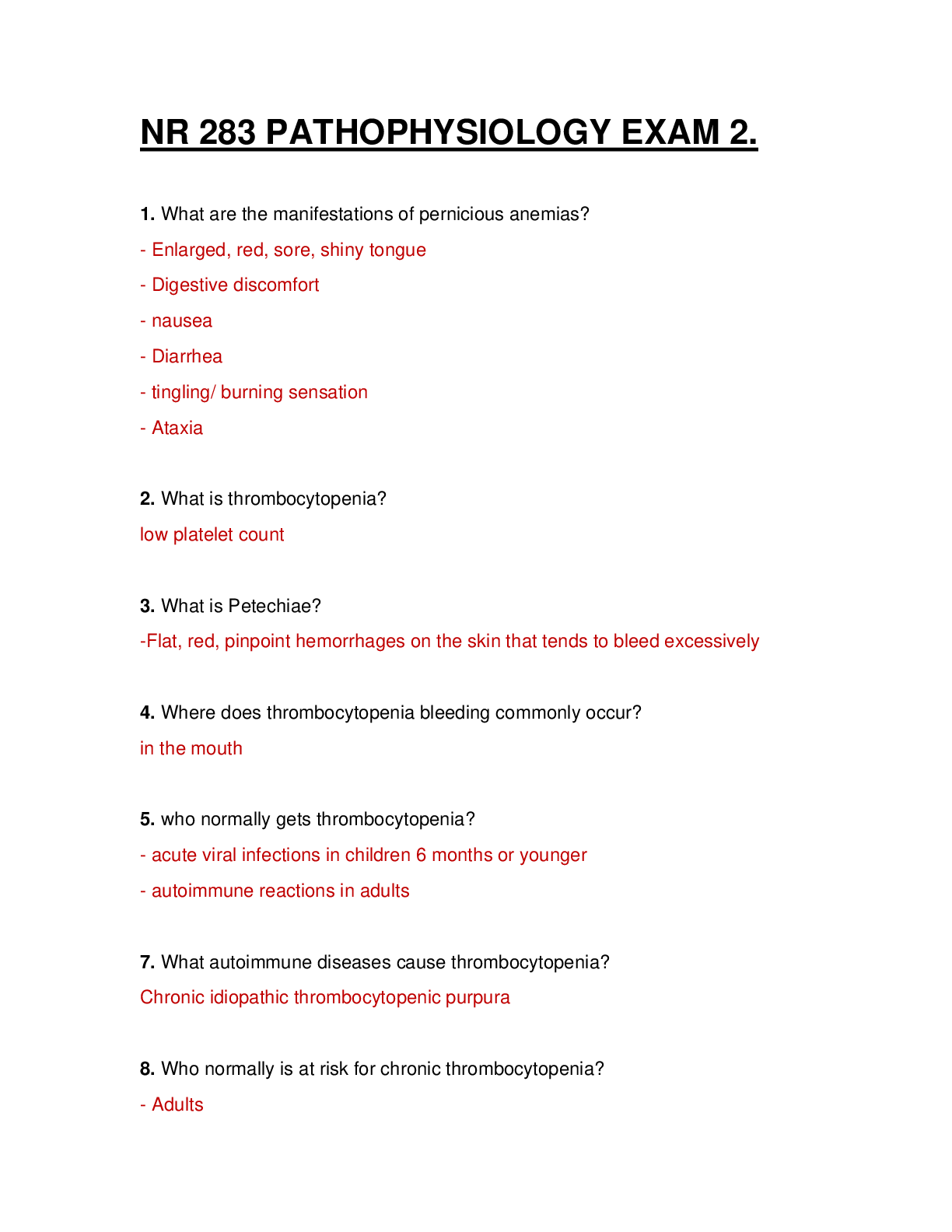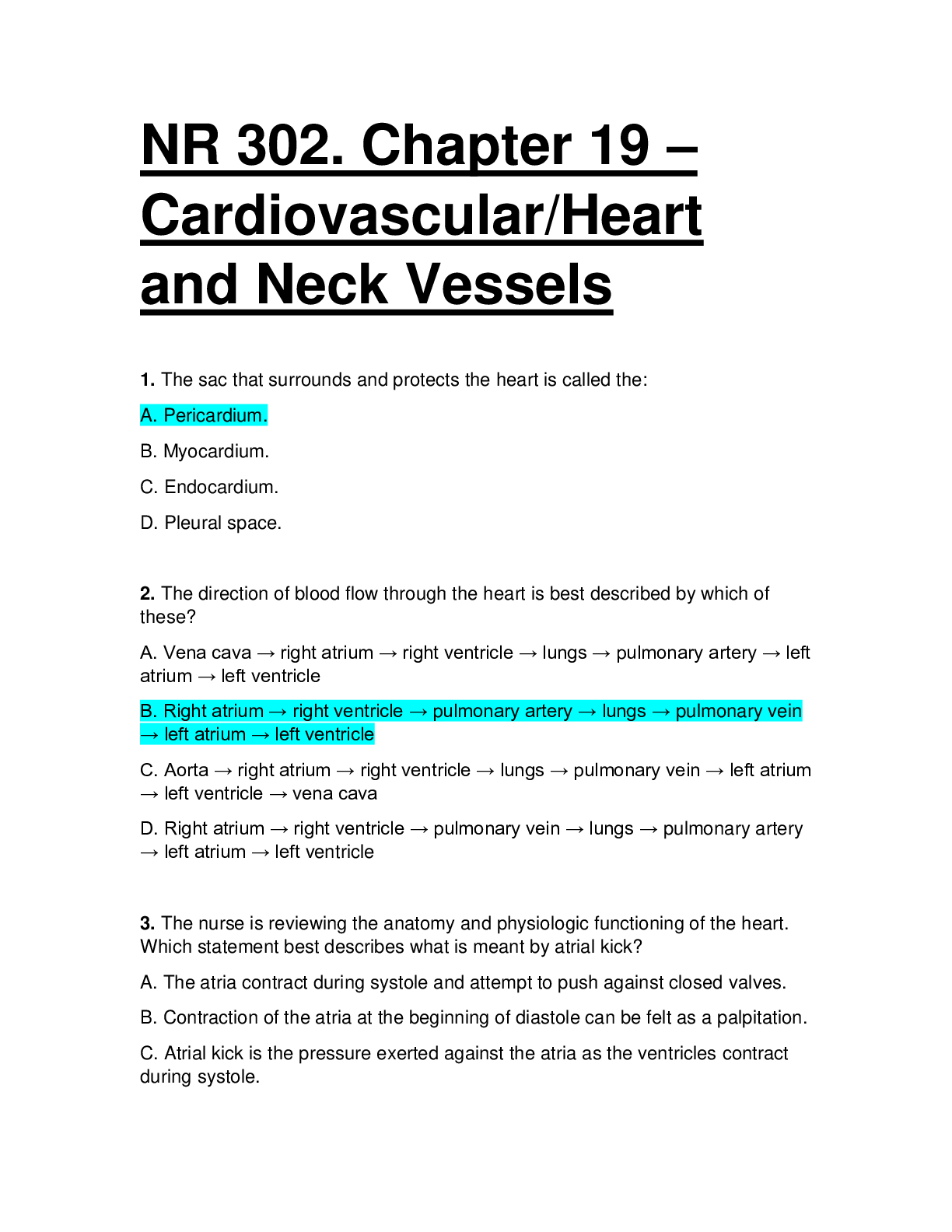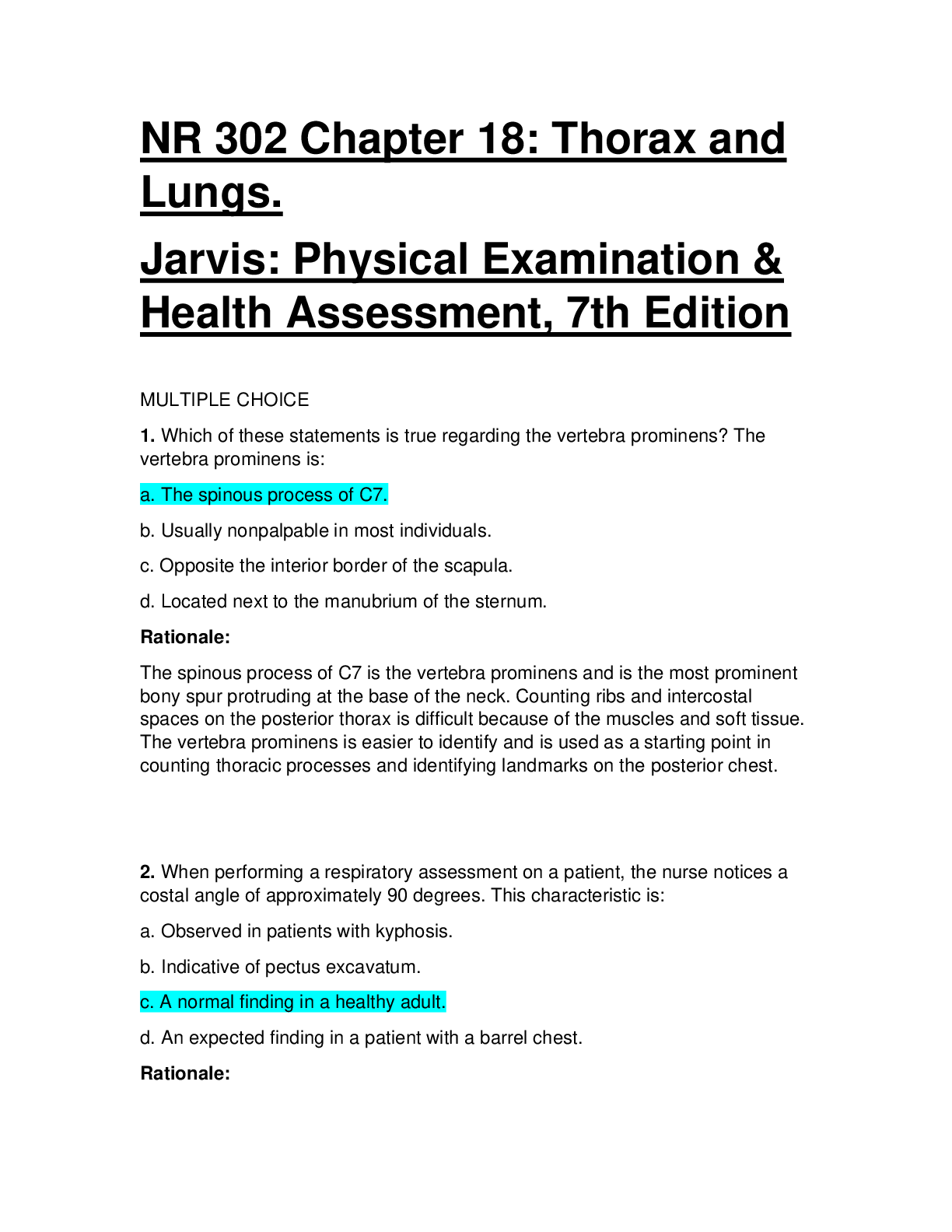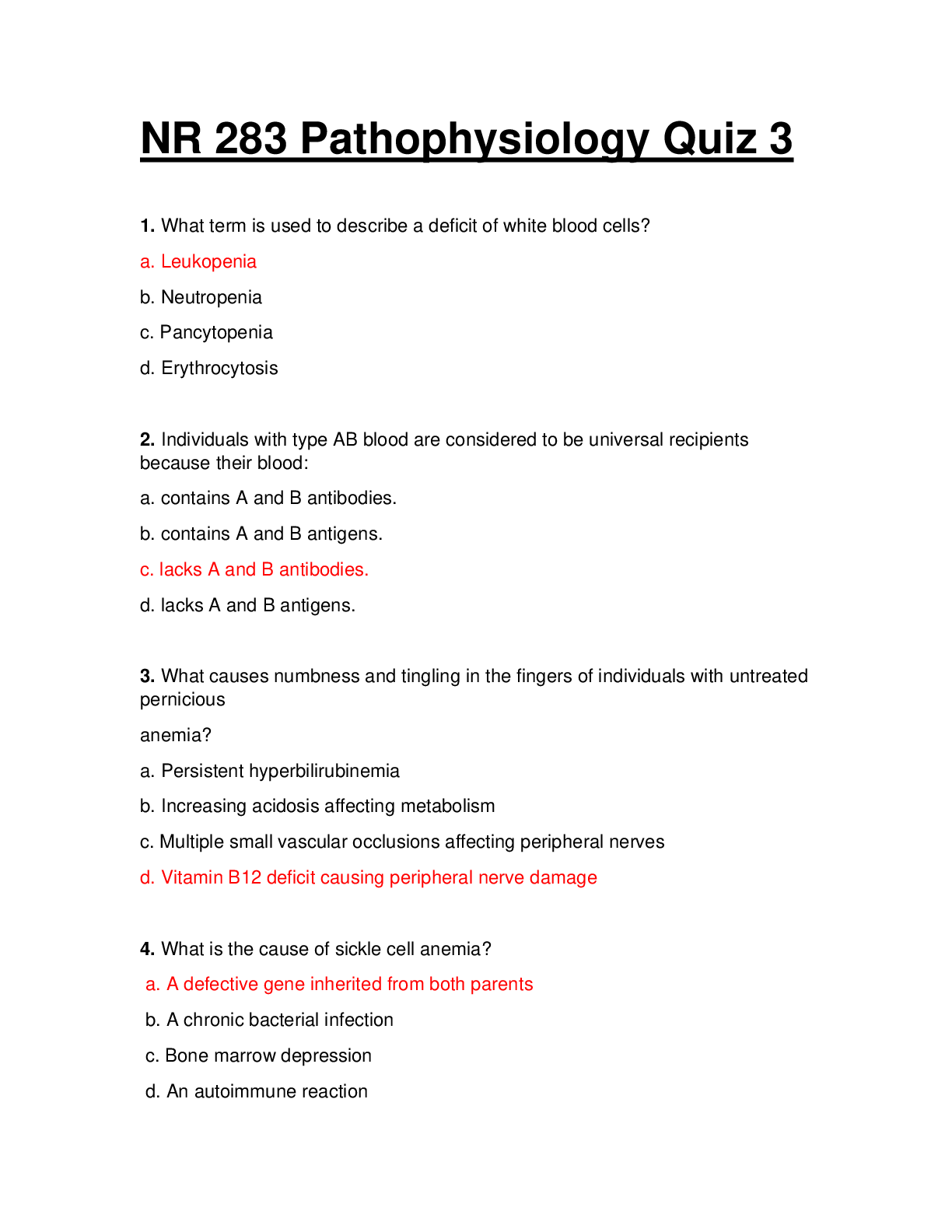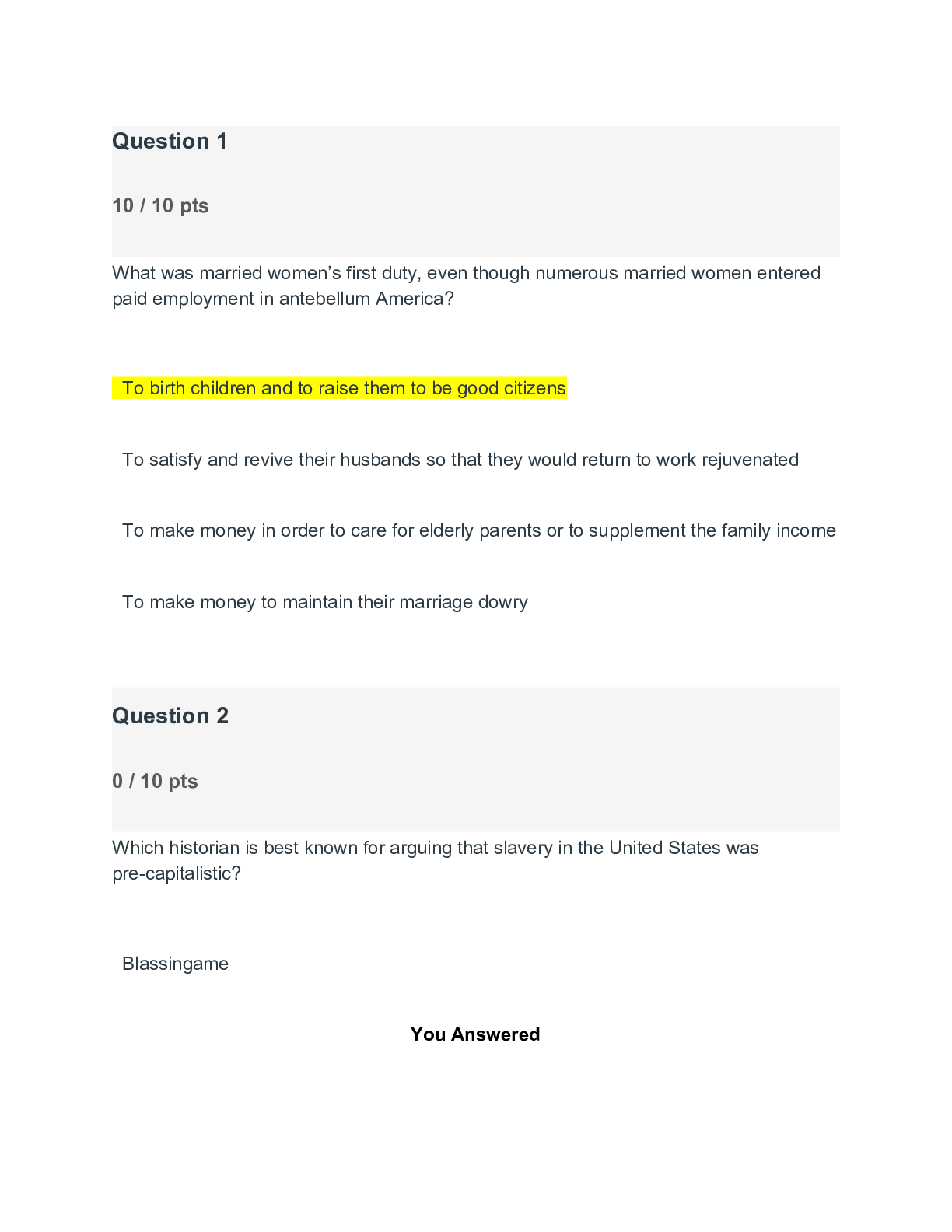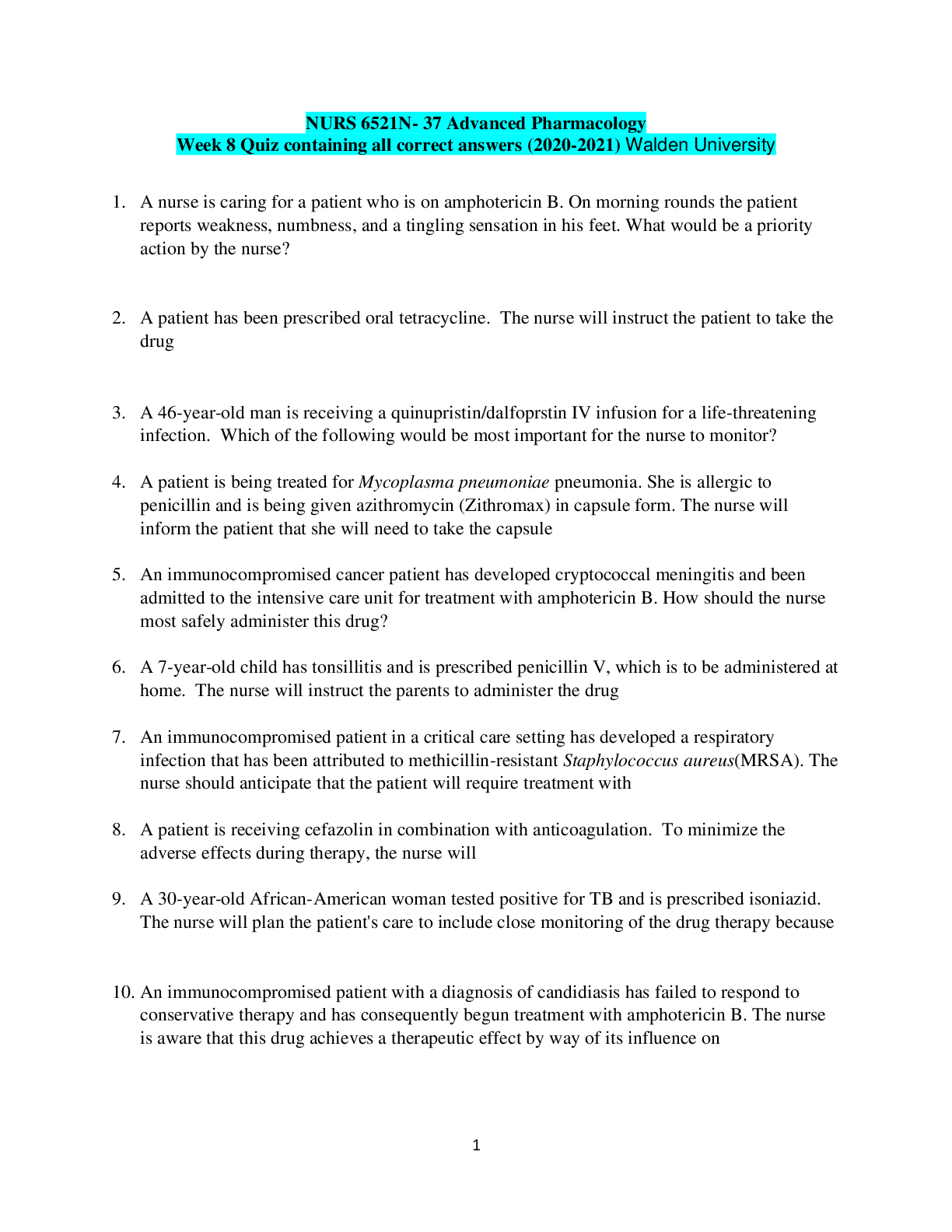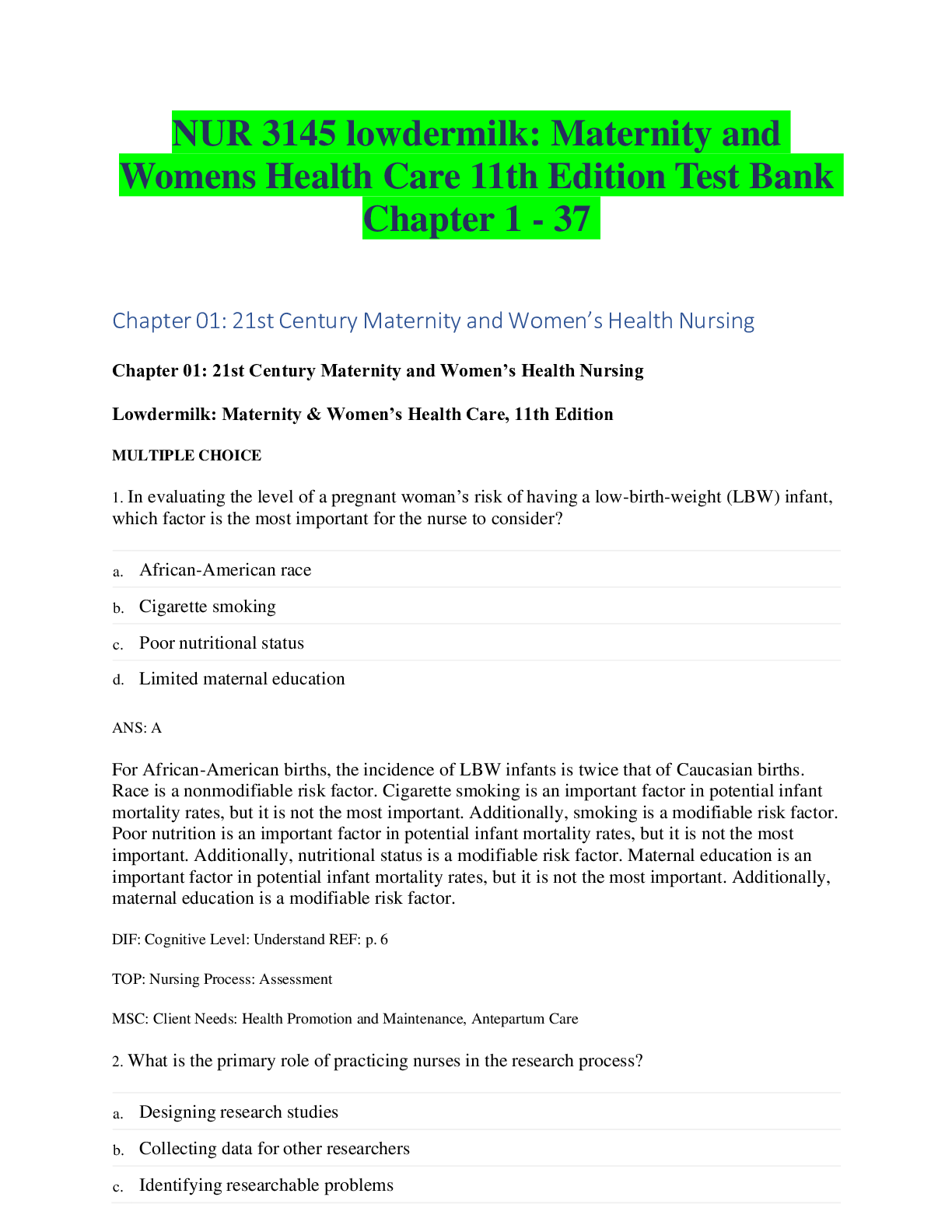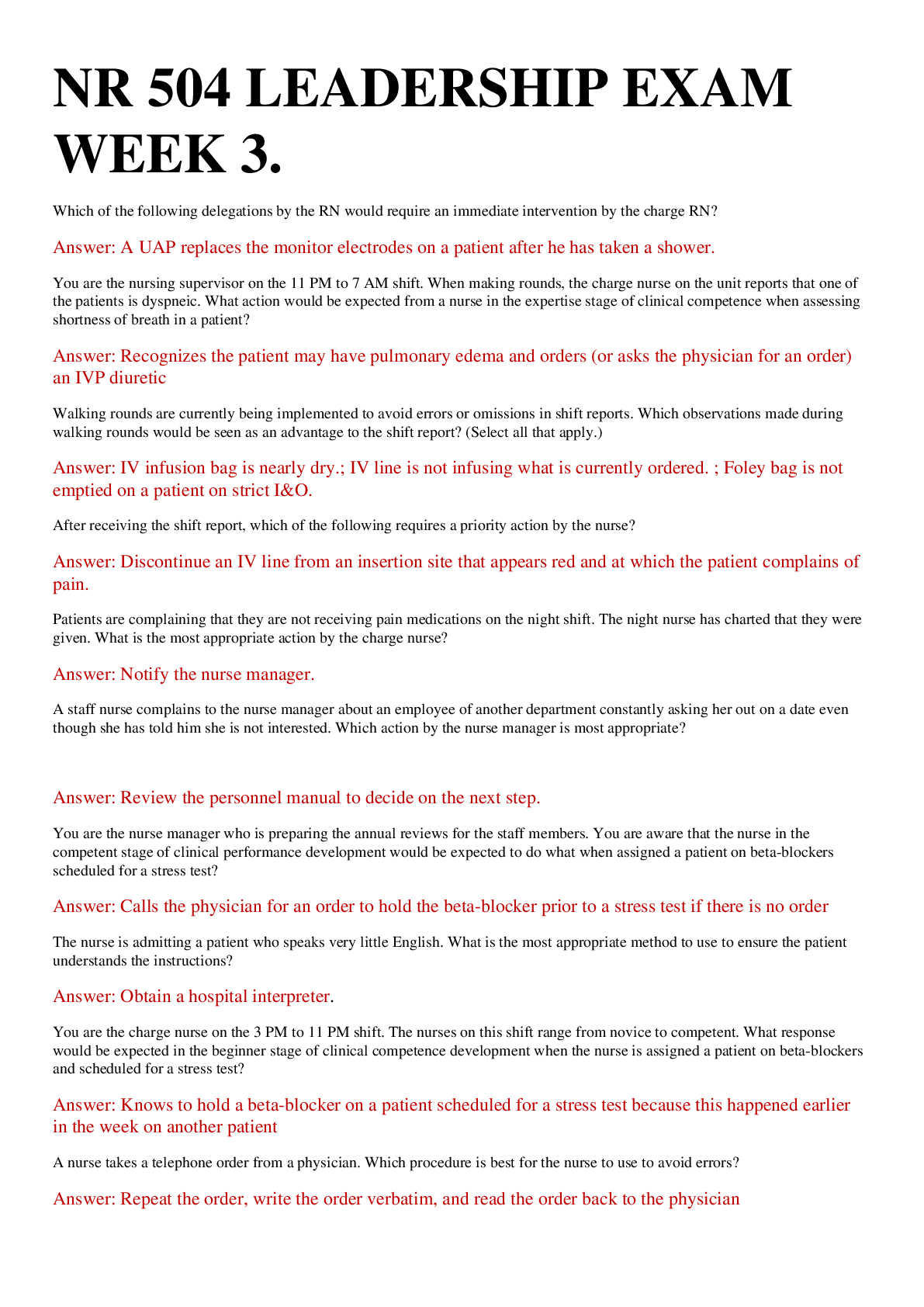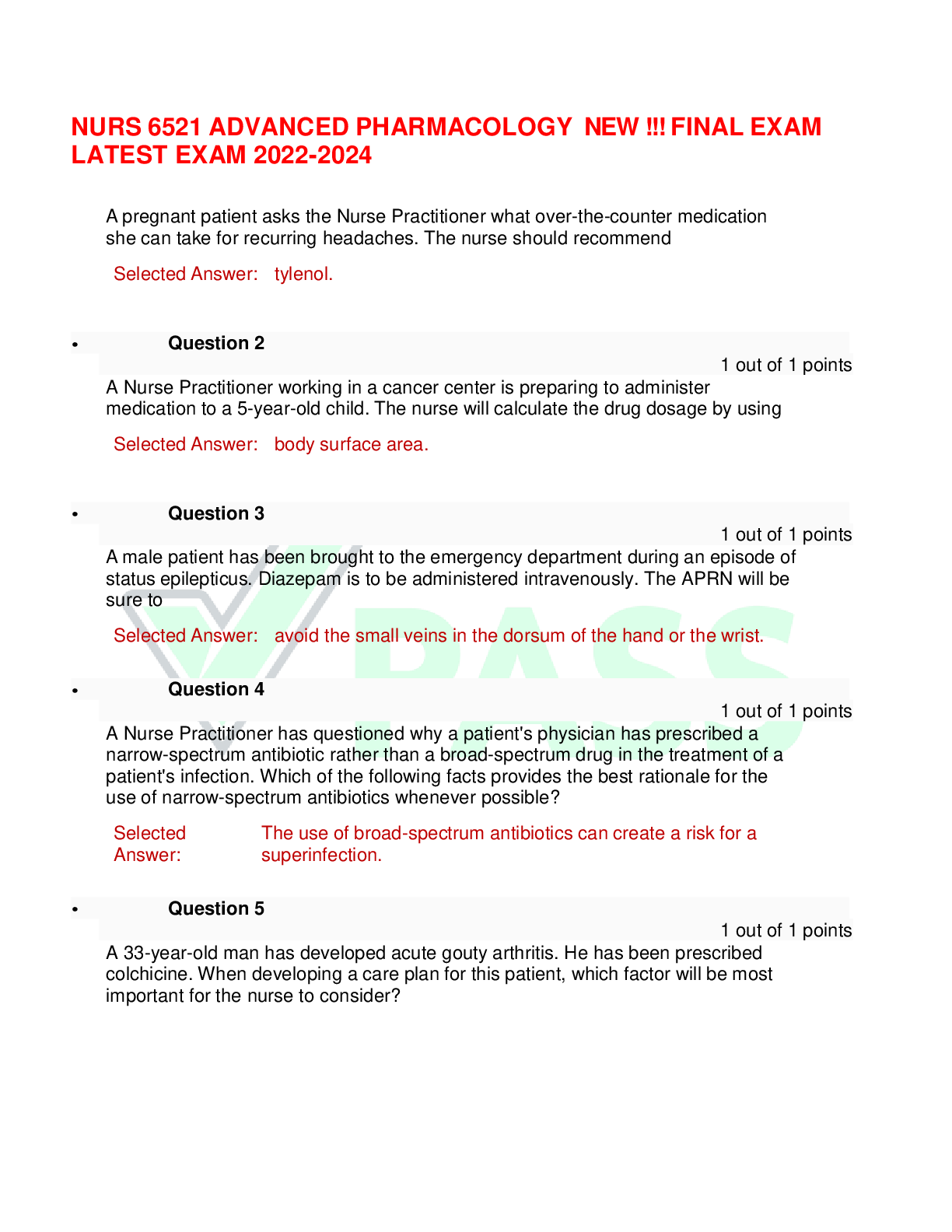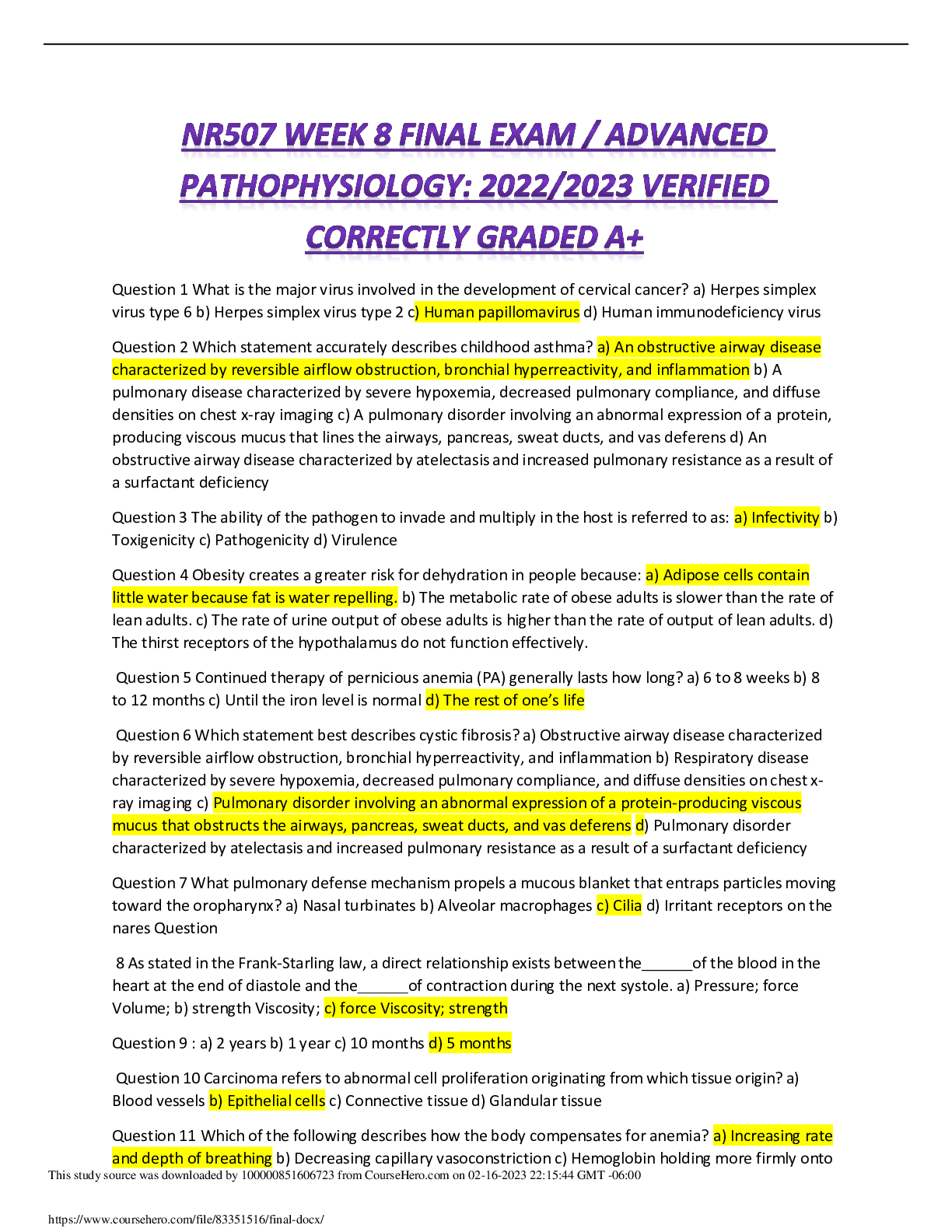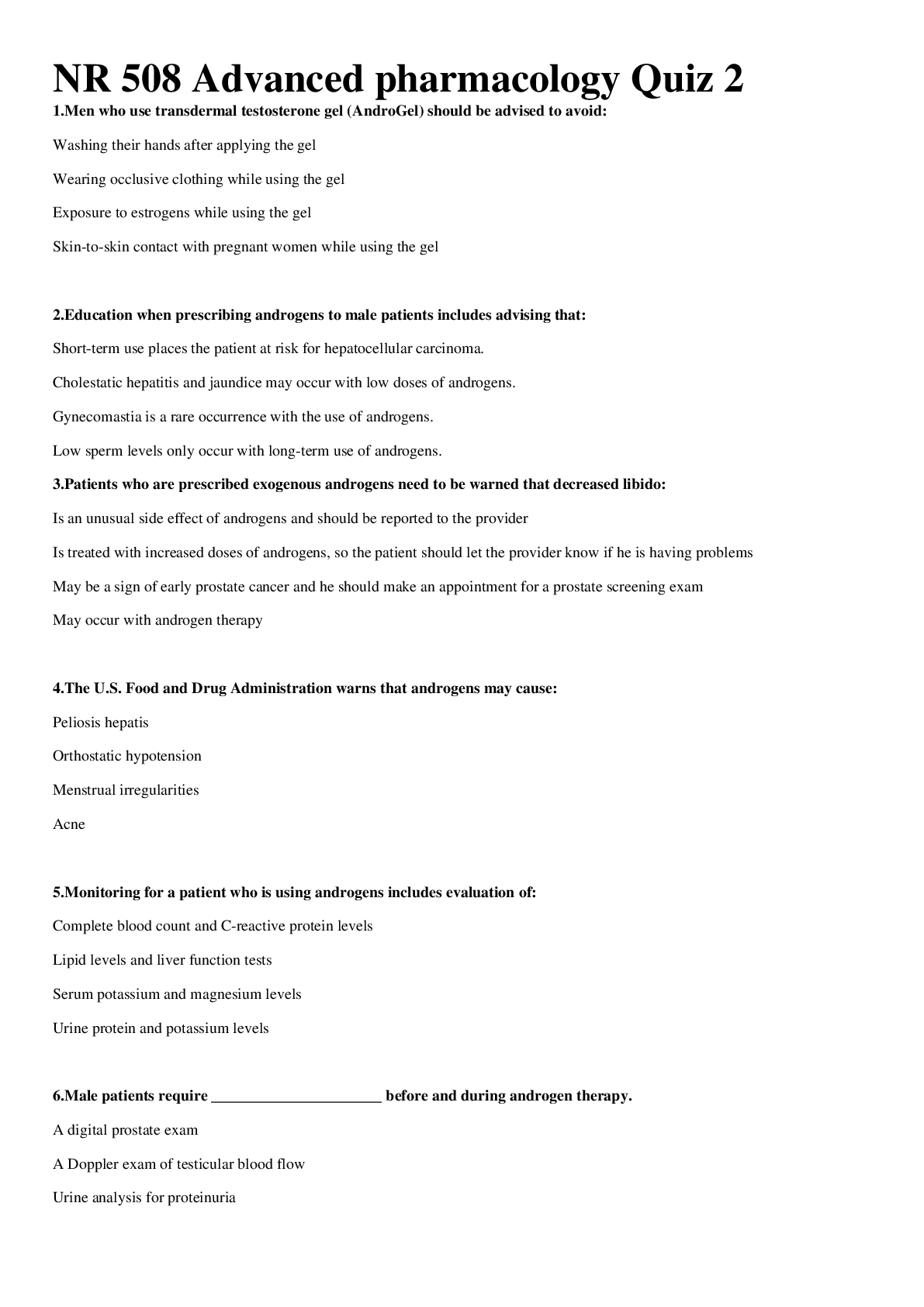Pharmacology > QUESTIONS & ANSWERS > NR 508 / NR508 ADVANCED PHARMACOLOGY WEEK 8 FINAL EXAM. QUESTIONS AND VERIFIED ANSWERS (All)
NR 508 / NR508 ADVANCED PHARMACOLOGY WEEK 8 FINAL EXAM. QUESTIONS AND VERIFIED ANSWERS
Document Content and Description Below
Question 1. Principles of prescribing for older adults include: 1. Avoiding prescribing any newer high-cost medications 2. Starting at a low dose and increasing the dose slowly 3. Keeping the tota... l dose at a lower therapeutic range 4. All of the above Question 2. Sadie is a 90-year-old patient who requires a new prescription. What changes in drug distribution with aging would influence prescribing for Sadie? 1. Increased volume of distribution 2. Decreased lipid solubility 3. Decreased plasma proteins 4. Increased muscle-to-fat ratio Question 3. Glen is an 82-year-old patient who needs to be prescribed a new drug. What changes in elimination should be taken into consideration when prescribing for Glen? 1. Increased glomerular filtration rate (GFR) will require higher doses of some renally excreted drugs. 2. Decreased tubular secretion of medication will require dosage adjustments. 3. Thin skin will cause increased elimination via sweat. 4. Decreased lung capacity will lead to measurable decreases in lung excretion of drugs. Question 4. A medication review of an elderly person's medications involves: 1. Asking the patient to bring a list of current prescription medications to the visit 2. Having the patient bring all of their prescription, over-the-counter, and herbal medications to the visit 3. Asking what other providers are writing prescriptions for them 4. All of the above Question 5. Steps to avoid polypharmacy include: 1. Prescribing two or fewer drugs from each drug class 2. Reviewing a complete drug history every 12 to 18 months 3. Encouraging the elderly patient to coordinate their care with all of their providers 4. Evaluating for duplications in drug therapy and discontinuing any duplications Question 6. Robert is a 72-year-old patient who has hypertension and angina. He is at risk for common medication practices seen in the elderly including: 1. Use of another person's medications 2. Hoarding medications 3. Changing his medication regimen without telling his provider 4. All of the above Question 7. To improve positive outcomes when prescribing for the elderly the nurse practitioner should: 1. Assess cognitive functioning in the elder 2. Encourage the patient to take a weekly "drug holiday" to keep drug costs down 3. Encourage the patient to cut drugs in half with a knife to lower costs 4. All of the above Question 8. hen an elderly diabetic patient is constipated the best treatment options include: 1. Mineral oil 2. Bulk-forming laxatives such as psyllium 3. Stimulant laxatives such as senna 4. Stool softeners such as docusate Question 9. Delta is an 88-year-old patient who has mild low-back pain. What guidelines should be followed when prescribing pain management for Delta? 1. Keep the dose of oxycodone low to prevent development of tolerance. 2. Acetaminophen is the first-line drug of choice. 3. Avoid prescribing NSAIDs. 4. Add in a short-acting benzodiazepine for a synergistic effect on pain. Question 10. Robert is complaining of poor sleep. Medications that may contribute to sleep problems in the elderly include: 1. Diuretics 2. Trazodone 3. Clonazepam 4. Levodopa Question 11. The GFRs for a 91-year-old woman who weighs 93 pounds and is 5'1" with a serum creatinine of 1.1, and for a 202-pound, 25-year-old male who is 5'9" with the same serum creatinine according to the Cockcroft Gault formula are: 1. 25ml/ min and 133 mL/min respectively 2. 25 mL/min and 103 mL/min respectively 3. 22 ml/min and 133 mL/min respectively 4. 22 ml/min and 103 mL/min respectively RAT: Remember to use ideal body weight (IBW) in the formula. The woman's IBW is 105 pounds and the man's is 156 pounds. Note the huge difference in GFR based on weight and age and the fact that looking at the serum creatinine alone can be very misleading in predicting GFR. Question 12. In geriatric patients, the percentage of body fat is increased. What are the pharmacologic implications of this physiologic change? 1. A lipid-soluble medication will be eliminated more quickly and not work as well. 2. A lipid-soluble medication will accumulate in fat tissue and its duration of action may be prolonged. 3. Absorption of lipid-soluble drugs is impaired in older adults. 4. The bioavailability of the lipid-soluble drug will be increased in older adults. RAT: Lipid medications will accumulate in fatty tissues prolonging the half-lives of these drugs. Question 13. All of the following statements about the Beer's List are true except: 1. It is a list of medications or medication classes that should generally be avoided in persons 65 years or older because they are either ineffective or they pose unnecessarily high risk for older persons and a safer alternative is available. 2. It is derived from the expert opinion of one geriatrician and is not evidence-based. 3. These criteria have been adopted by the Centers for Medicare and Medicaid Services for regulation of long-term care facilities. 4. These criteria are directed at the general population of patients over 65 years of age and do not take disease states into consideration. RAT: The Beer's criteria are intended as a guide and not a punitive regulatory tool. In 2011, the American Geriatrics Society (AGS) assembled a team to develop an evidence-based tool based on the original work of geriatrician Dr. Beers. Disease states are discussed in the updated AGS version. Question 14. You are reviewing the data from several meta-analyses that addressed the most common causes of adverse drug reactions in the older adult. Which of the following would you find to be decreased and the most common cause of these problems in older adults? 1. Body fat content 2. Liver function 3. Renal function/clearance 4. Plasma albumin levels Renal function declines with age, causing drug elimination to be slowed in older adults. Older adults have increased body fat. Liver dysfunction and hypoalbuminemia are not normal age-related changes but can be seen in association with disease states. Question 15. Which of the following is not consistent with the rules for geriatric prescribing: 1. Half-life will be longer in older adults 2. Steady state is reached more quickly in the older adult 3. Reduce the number of drugs in the patient's regimen whenever possible 4. Adverse drug responses present atypically in the older adult RAT: Due to an increased half-life of lipid-soluble drugs, steady state will likely take longer to achieve in older adults. The other statements are true with respect to geriatric prescribing. Question 16. The Pediatric Research Equity Acts requires: 1. All children be provided equal access to drug research trials 2. Children to be included in the planning phase of new drug development 3. That pediatric drug trials guarantee children of multiple ethnic groups are included 4. All applications for new active ingredients, new indications, new dosage forms, or new routes of administration require pediatric studies Question 17. The Best Pharmaceuticals for Children Act: 1. Includes a pediatric exclusivity rule which extends the patent on drugs studied in children 2. Establishes a committee that writes guidelines for pediatric prescribing 3. Provides funding for new drug development aimed at children 4. Encourages manufacturers specifically to develop pediatric formulations Question 18. The developmental variation in Phase I enzymes has what impact on pediatric prescribing? 1. None, Phase I enzymes are stable throughout childhood. 2. Children should always be prescribed lower than adult doses per weight due to low enzyme activity until puberty. 3. Children should always be prescribed higher than adult doses per weight due to high enzyme activity. 4. Prescribing dosages will vary based on the developmental activity of each enzyme, at times requiring lower than adult doses and other times higher than adult doses based on the age of the child. Question 19. Developmental variation in renal function has what impact on prescribing for infants and children? 1. Lower doses of renally excreted drugs may be prescribed to infants younger than age 6 months. 2. Higher doses of water soluble drugs may need to be prescribed because of increased renal excretion. 3. Renal excretion rates have no impact on prescribing. 4. Parents need to be instructed on whether drugs are renally excreted or not. Question 20. Topical corticosteroids are prescribed cautiously in young children because: 1. They may cause an intense hypersensitivity reaction 2. Of hypothalamic-pituitary-adrenal axis suppression 3. Corticosteroids are less effective in young children 4. Young children may accumulate corticosteroids, leading to toxic levels Question 21. Liza is breastfeeding her 2-month-old son and has an infection that requires an antibiotic. What drug factors influence the effect of the drug on the infant? 1. Maternal drug levels 2. Half-life 3. Lipid-solubility 4. All of the above Question 22. Drugs that are absolutely contraindicated in lactating women include: 1. Selective serotonin reuptake inhibitors 2. Antiepileptic drugs such as carbamazepine 3. Antineoplastic drugs such as methotrexate 4. All of the above Question 23. Zia is a 4-month-old patient with otitis media. Education of his parents regarding administering oral antibiotics to an infant includes: 1. How to administer an oral drug using a medication syringe 2. Mixing the medication with a couple of ounces of formula and putting it in a bottle 3. Discontinuing the antibiotic if diarrhea occurs 4. Calling for an antibiotic change if the infant chokes and sputters during administration Question 24. To increase adherence in pediatric patients a prescription medication should: 1. Have a short half-life 2. Be the best tasting of the effective drugs 3. Be the least concentrated form of the medication 4. Be administered 3 or 4 times a day Question 25. Janie is a 5-month-old breastfed infant with a fever. Treatment for her fever may include: 1. "Baby" aspirin [Show More]
Last updated: 1 year ago
Preview 1 out of 11 pages
Instant download

Buy this document to get the full access instantly
Instant Download Access after purchase
Add to cartInstant download
Reviews( 0 )
Document information
Connected school, study & course
About the document
Uploaded On
Feb 10, 2021
Number of pages
11
Written in
Additional information
This document has been written for:
Uploaded
Feb 10, 2021
Downloads
0
Views
49


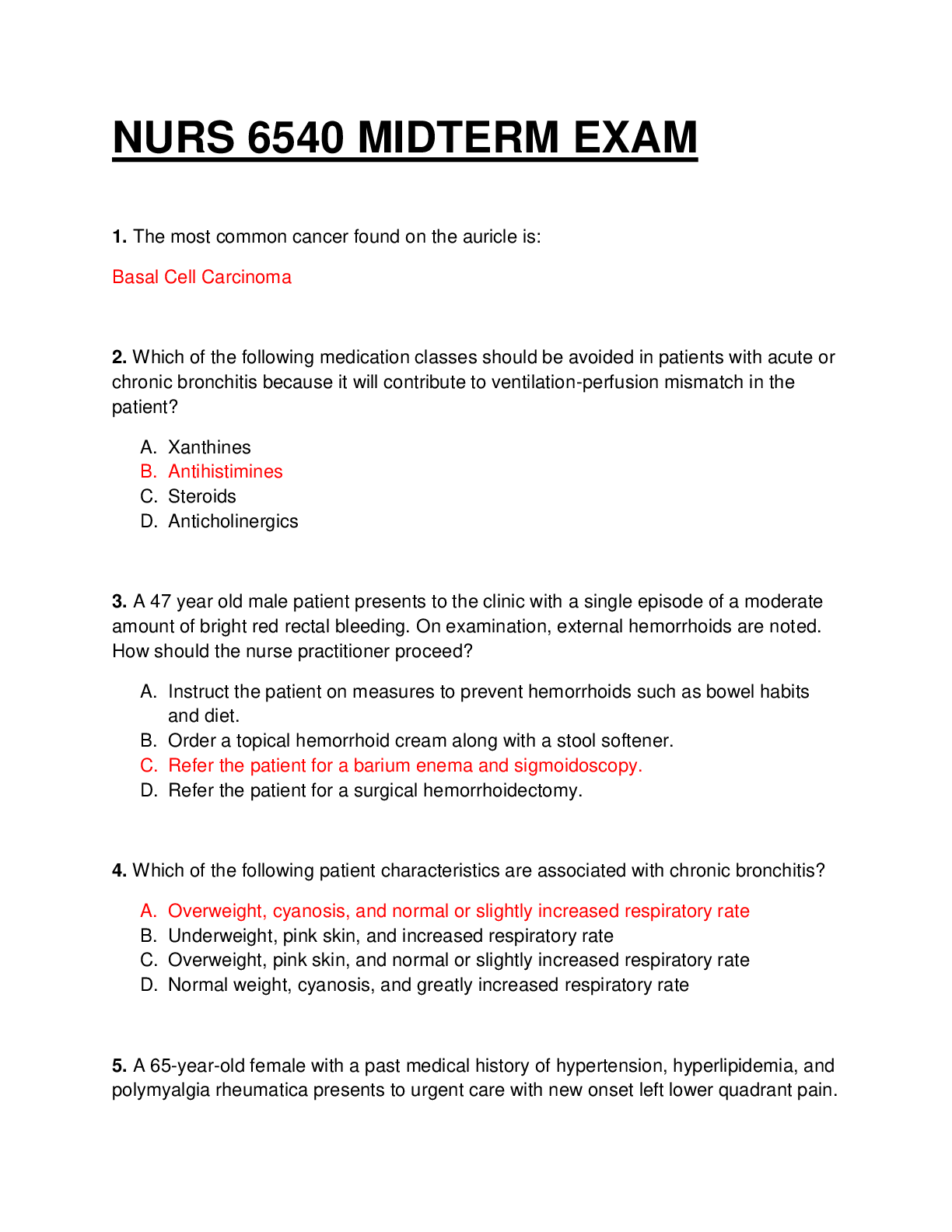
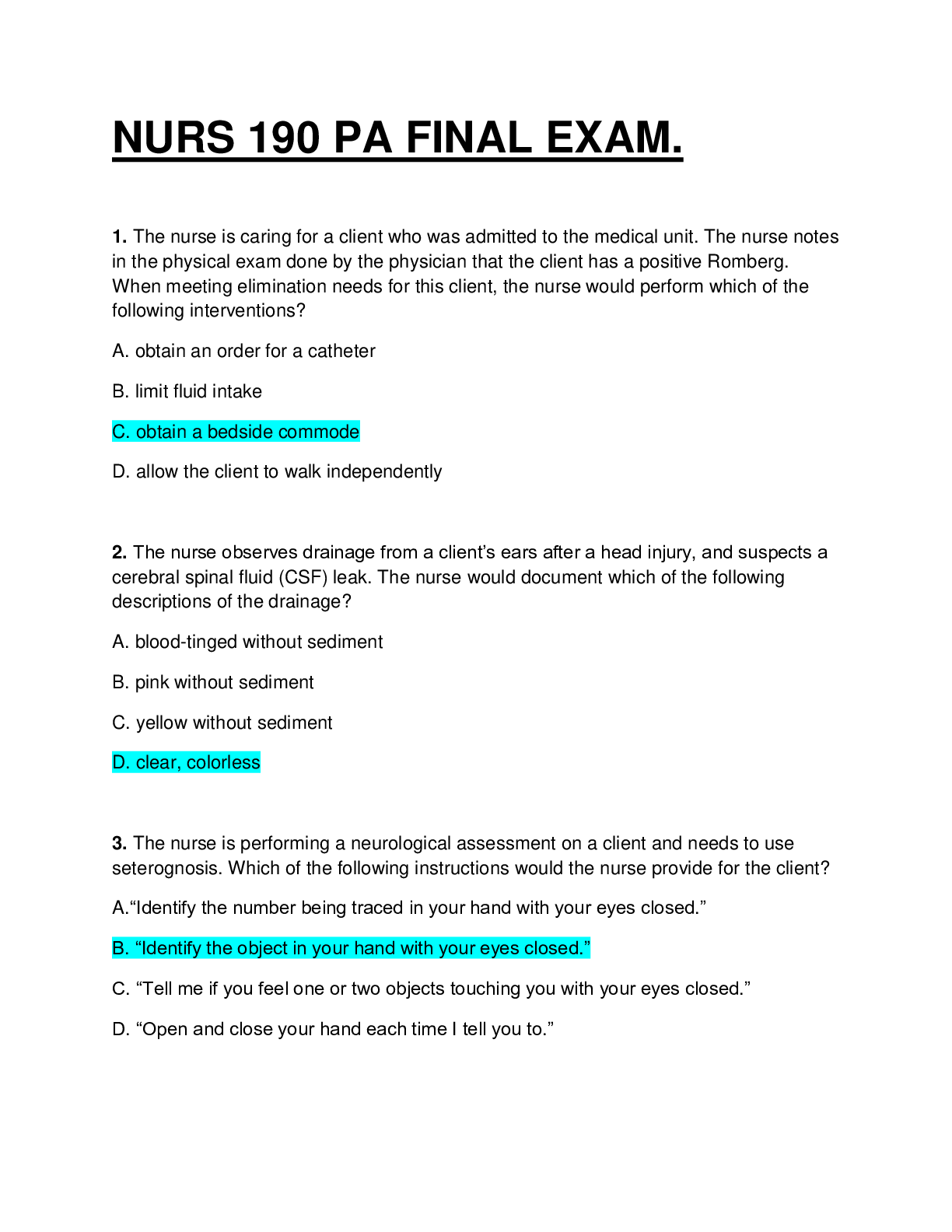

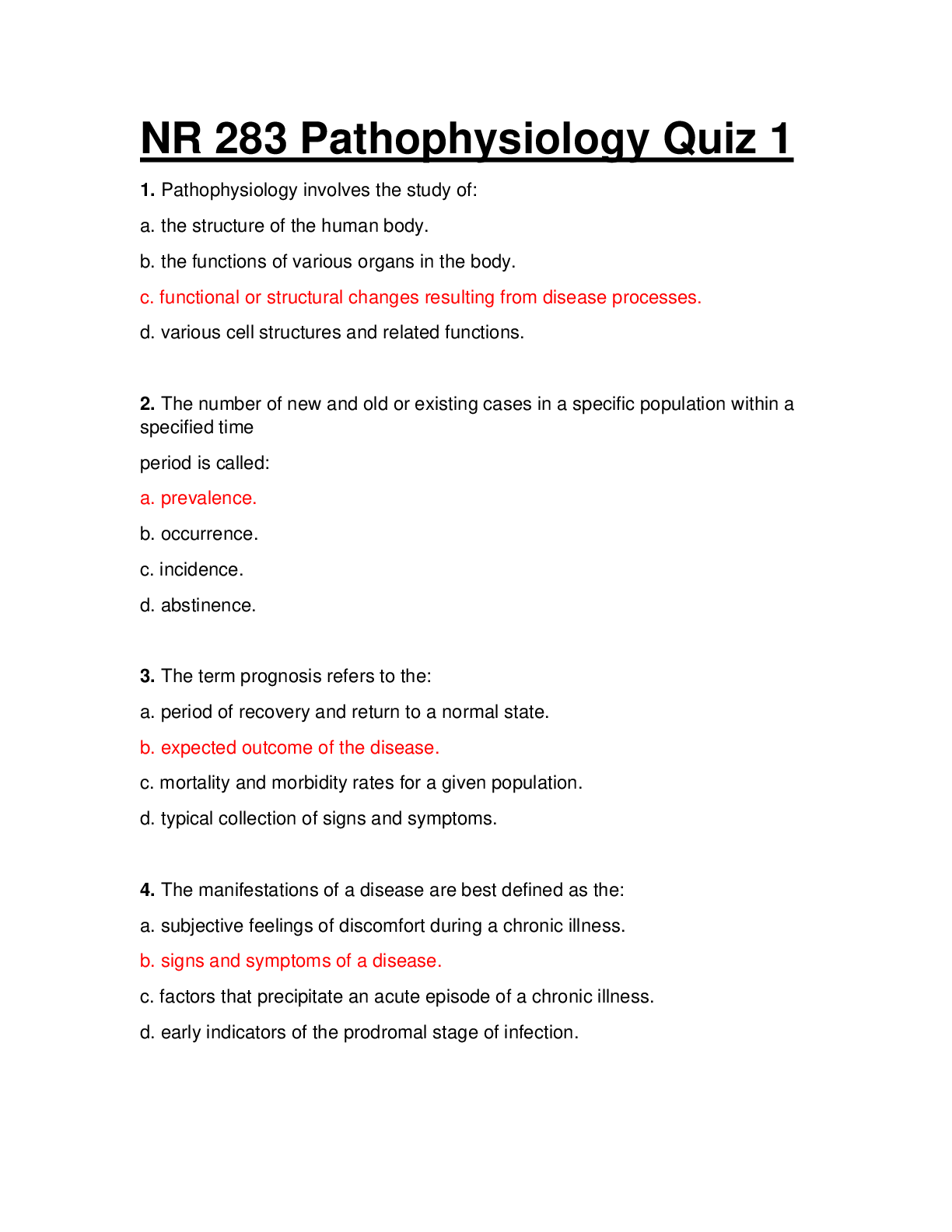

.png)
